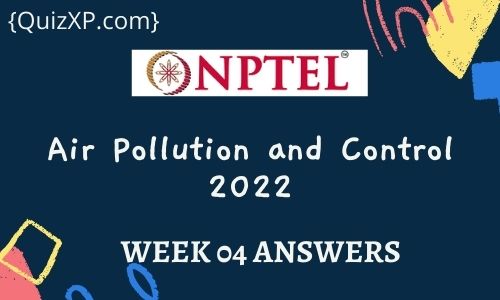Are you looking for the Answers to NPTEL Air Pollution and Control Assignment 4? This article will help you with the answer to the National Programme on Technology Enhanced Learning (NPTEL) Course “ NPTEL Air Pollution and Control Assignment 4 “
What is Air Pollution and Control?
The objective of the course is to impart the knowledge and understanding of causes and effects of air pollution and their controlling mechanisms. The course will provide a deeper understanding of air pollutants, pollution inventory and modelling. The course also imparts knowledge on the impacts of air pollution on different aspects such as policy, human health and various contemporary technological innovation for betterment of air quality.
CRITERIA TO GET A CERTIFICATE
Average assignment score = 25% of the average of best 8 assignments out of the total 12 assignments given in the course.
Exam score = 75% of the proctored certification exam score out of 100
Final score = Average assignment score + Exam score
YOU WILL BE ELIGIBLE FOR A CERTIFICATE ONLY IF THE AVERAGE ASSIGNMENT SCORE >=10/25 AND EXAM SCORE >= 30/75. If one of the 2 criteria is not met, you will not get the certificate even if the Final score >= 40/100.
Below you can find the answers for NPTEL Air Pollution and Control Assignment 4
| Assignment No. | Answers |
|---|---|
| Air Pollution Assignment 1 | Click Here |
| Air Pollution Assignment 2 | Click Here |
| Air Pollution Assignment 3 | Click Here |
| Air Pollution Assignment 4 | Click Here |
| Air Pollution Assignment 5 | Click Here |
| Air Pollution Assignment 6 | Click Here |
| Air Pollution Assignment 7 | Click Here |
| Air Pollution Assignment 8 | Click Here |
NPTEL Air Pollution and Control Assignment 4 Answers:-
Q1. The Gaussian plume model-based estimations of the concentrations of a pollutant are not reliable beyond the radius of approximately _________
a) 15km
b) 20km
c) 25km
d) 30km
Q2. In the downwind direction from an air pollution source, with the increasing distance, the lateral and vertical dispersion coefficients will
a) Remain constant
b) Decrease
c) Increase
d) Initially increase and then decrease
Answer:- c
Q3. Which of the following is not an example of line source of air pollution?
a) Motor Vehicles travelling along a straight section of a highway
b) Agricultural burning along the edge of a field
c) Fire in a large area of a forest
d) A line of industrial sources on the bank of a river etc
Answer:- c
Q4. The expression for determination of concentration (C) of a pollutant using Gaussian dispersion model for a line source is given as:
Answer:- c
Q5. Sulfur dioxide is emitted at a rate of 150 g/s from a stack with an effective height of 60 m. The wind speed at stack height is 5 m/s, and the atmosphere stability class is D for the overcast day. (Given, σy = 38 m and σz = 19 m). Ground-level concentration along the center line at a distance of 500 m from the stack, in micrograms per cubic meter (µg/m3).
a) 40 µg/m3
b) 60 µg/m3
c) 90 µg/m3
d) 100 µg/m3
Answer:- c
Q6. Estimate the total hydrocarbon concentration at a point 300 m downwind from an expressway at 5:30 P.M on an overcast day. The wind is perpendicular to the highway and has a speed of 4 m/s. The traffic density along the highway is 8000 vehicles per hour, and the average vehicle speed is 40 mi/hr. The average vehicle emission rate of hydrocarbons is 2×10-2 g/s.
a) 32 µg/m3
b) 42 µg/m3
c) 28 µg/m3
d) 58 µg/m3
Answer:- b
Q7. ___________ is the product of maximum mixing depth/height and the average wind speed within the mixing layer for a given region.
a) Ventilation Coefficient
b) Pollutant Concentration
c) Pollution potential
d) Atmospheric stability
Answer:- a
Q8. ________________ of an air environment is the maximum amount of pollution load that can be discharged into it without violating the best designated use of the air resource in the planning region.
a) Assimilative capacity
b) Airshed
c) Ventilation coefficient
d) None of the above
Answer:-a
Q9. __________ is an average representative value that is related to the quantity of an air pollutant released to the atmosphere due to a particular activity.
a) Correction factor
b) Activity Data
c) Assimilative capacity
d) Emission factor
Answer:- d
Q10. The basic equation for estimating the emissions from a particular sector is given as the product of :
a) Activity data and Emission factor
b) Activity data and Concentration of a pollutant
c) Emission factor and Average wind speed
d) Emission factor and Concentration of a pollutant
Answer:- a
For other courses answers:- Visit
For Internship and job updates:- Visit
Disclaimer: We do not claim 100% surety of answers, these answers are based on our sole knowledge, and by posting these answers we are just trying to help students, so we urge do your assignment on your own.
if you have any suggestions then comment below or contact us at [email protected]
If you found this article Interesting and helpful, don’t forget to share it with your friends to get this information.

